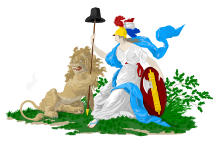
Back الفتاة الهولندية Arabic Doncella neerlandesa Spanish ഡച്ച് കന്യക Malayalam Nederlandse Maagd Dutch

The Dutch Maiden (Dutch: Nederlandse Maagd) is a national personification of the Netherlands. She is typically depicted wearing a Roman garment and with a lion, the Leo Belgicus, by her side. In addition to the symbol of a national maiden, there were also symbolic provincial maidens and town maidens.
The Dutch Maiden has been used as a national symbol since the 16th century. During the Dutch Revolt, a maiden representing the United Provinces of the Netherlands became a recurrent theme in allegorical cartoons. In early depictions she may be shown in the "Garden of Holland", a small garden surrounded by a fence, recalling the medieval hortus conclusus of the Virgin Mary. On 25 May 1694, the States of Holland and West Friesland introduced a uniform coin design for the United Provinces, showing a Dutch Maiden leaning on a bible placed on an altar and holding a lance with the cap of liberty, the Liberty pole.[1][2]

Initially carrying a martyr's palm, by the late 17th century she often carries a cap of liberty on a liberty pole, though the hat is a conventional male style for the period, rather than the Phrygian cap that later images of liberty personified in other countries used.[citation needed] Alongside the type of depiction with a liberty pole, which is usually costumed in more or less modern styles, images in the Baroque classical dress that was more conventional for such personifications are also found.
- ^ "De Munt en Munteryebetreffende" (PDF) (in Dutch). Archived from the original (PDF) on 2011-07-24. Retrieved 2011-02-07.
- ^ de Vries, Hubert; van de Nederlanden, Wapens (1995). De historische ontwikkeling van de heraldische symbolen van Nederland, België, hun provincies en Luxemburg (in Dutch). Amsterdam: Uitgeverij Jan Mets. p. 183, note 9.